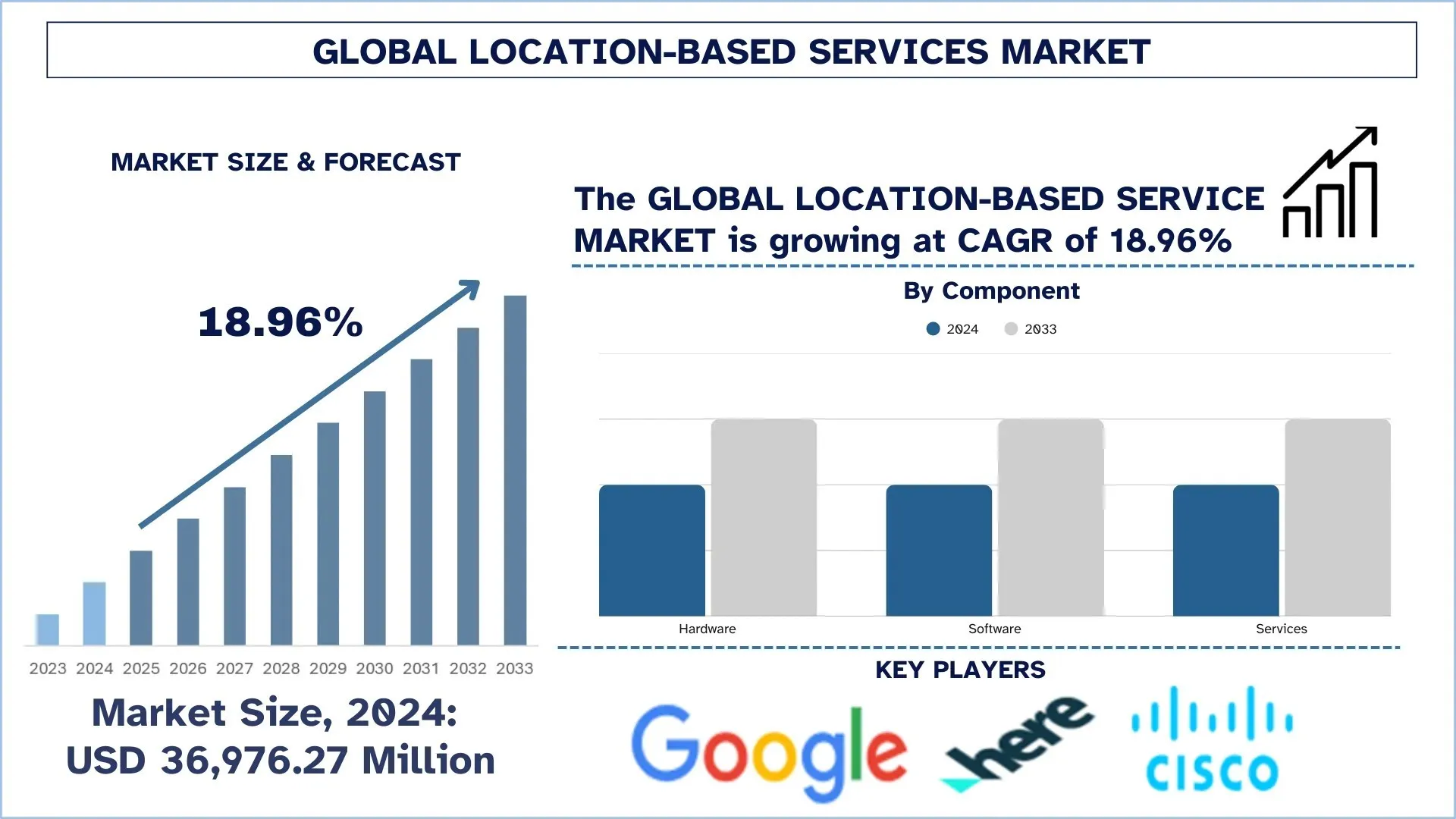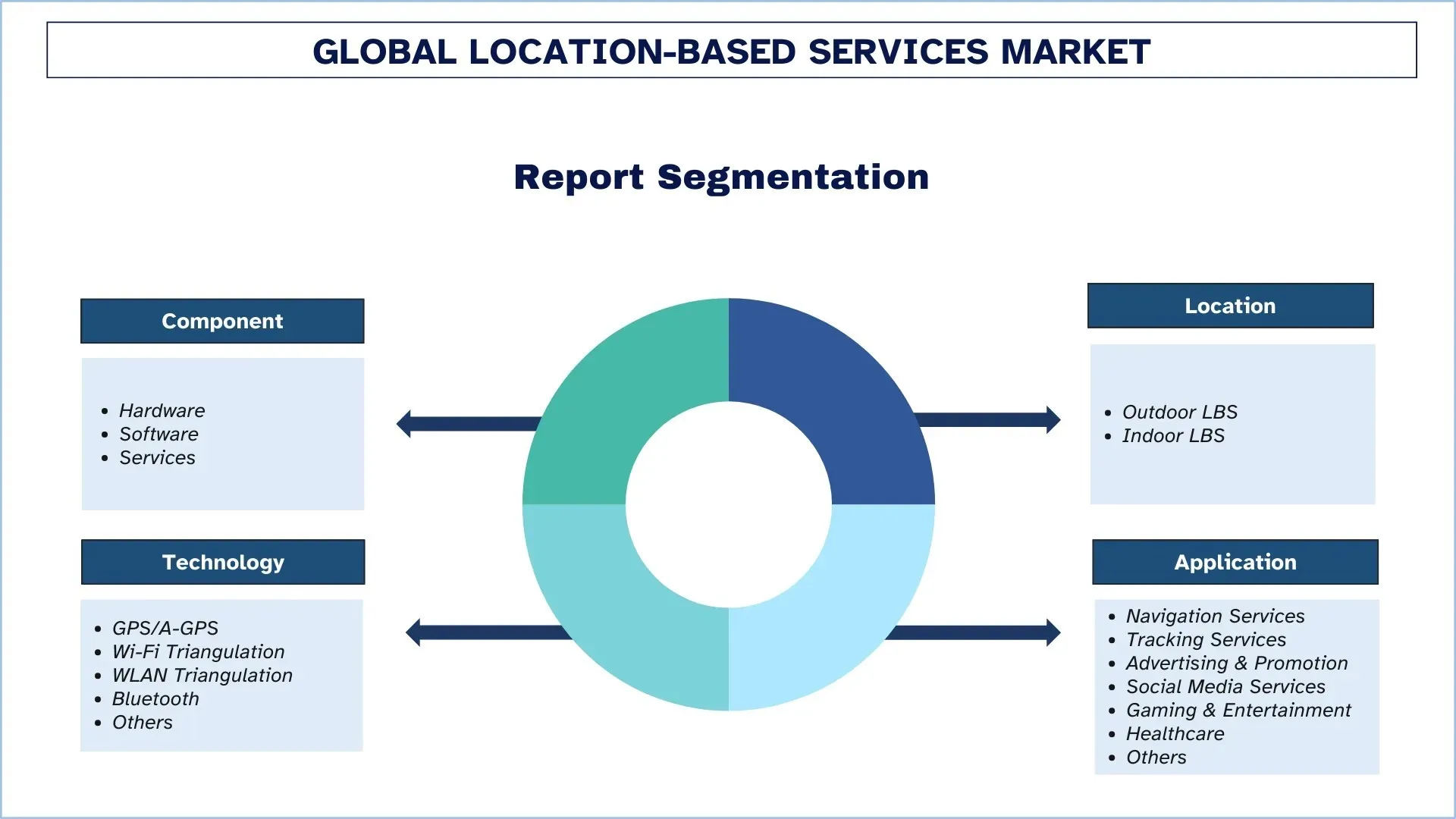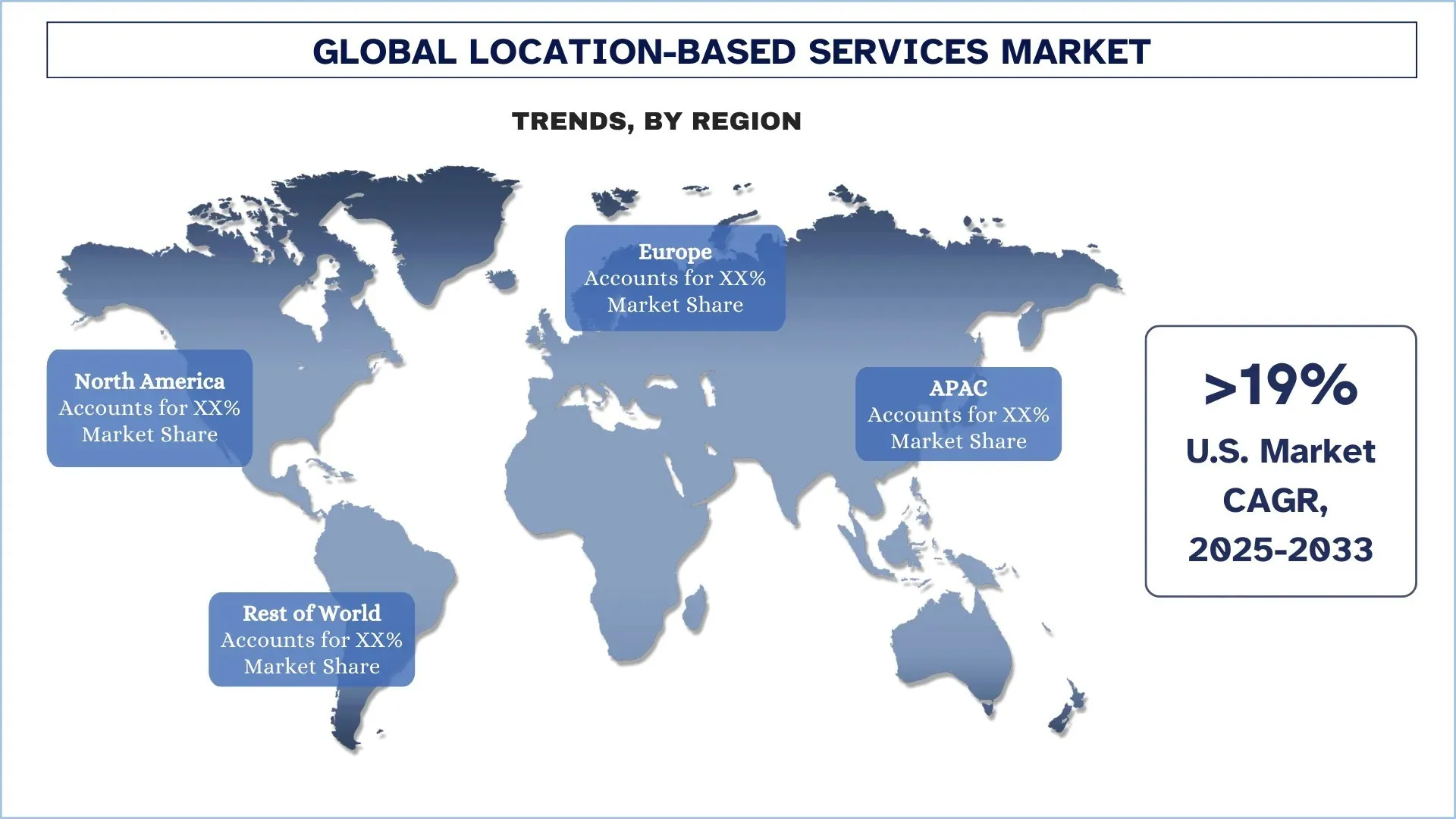- Home
- About Us
- Industry
- Services
- Reading
- Contact Us
Location-Based Services Market: Current Analysis and Forecast (2025-2033)
Emphasis on Component (Hardware, Software, and Services); Location (Outdoor LBS and Indoor LBS); Technology (GPS/A-GPS, Wi-Fi Triangulation, WLAN Triangulation, Bluetooth, and Others); Application (Navigation Services, Tracking Services, Advertising & Promotion, Social Media Services, Gaming & Entertainment, Healthcare, and Others); and Region/Country

Global Location-Based Services Market Size & Forecast
The Global Location-Based Services Market was valued at USD 36,976.27 million in 2024 and is expected to grow at a CAGR of around 18.96% during the forecast period (2025–2033F), driven by increased use of smartphones and mobile devices, expansion of the smart city network, and the growth of on-demand services.
Location-Based Services Market Analysis
Location-based service is a software service for mobile devices and smartphones. These applications and devices use the customer's live location and make decisions according to the generated geo-data based on the user's location. Additionally, many companies, such as food delivery companies like Swiggy, Zomato, and Uber Eats, use LBS to track the user location and match the delivery agent and customer location. Navigation services such as Google Maps and Azure Maps also use LBSs. Google Map communicate with satellite signals using GPS and generates data. Further, using a variety of GPS data, it then creates an imaginary map. Google Maps also tracks traffic conditions and provides updates, reducing the time for users. Additionally, people can use location-specific information based on their current destination or locality. Many big companies are increasing the use of proximity services. Companies use technologies such as Bluetooth location, Wi-Fi location, or geodata to identify consumer location or surroundings, and based on that, they send personalized messages, offers, coupons, notifications, or advertisements to their smartphones after tracking their location or surroundings, which can help them make informed decisions.

Global Location-Based Services Market Trends
This section discusses the key market trends that are influencing the various segments of the global location-based services market, as found by our team of research experts.
Increased Use of Proximity Services
Among the major trends in the Location-Based Service market, the increased use of proximity services is the most prominent one. Proximity services are part of a location-based experience that occurs when a user, a device, or an object approaches a specific place or object. They are based on Bluetooth Low Energy Beacons, NFC, Wi-Fi, UWB, and small area geofences to identify proximity with great precision. Some common applications are retail offers, check-in without a line, indoor navigation, asset tracking, social discovery, and safety alerts. Proximity services increase engagement and efficiency and are only possible through timing and place, whereas privacy, consent, and on-device processing are fundamental design imperatives today. Companies use location-based services to send personalized notifications, offers, and discounts to customers’ devices when they are near a specific spot. Proximity services depend on Wi-Fi, GPS, and Bluetooth networks to find when the customer is near a specific store, mall, or restaurant. For example, retail stores such as Big Bazar use proximity service to send offers or discounts to the user’s device when they are inside or near the store. Additionally, the airport provides updates to passengers regarding gate changes or boarding when they are near a particular terminal using proximity services. Hence, proximity services allow companies to send notifications and messages at the right time and place, improving sales and customer engagement.
Location-Based Services Industry Segmentation
This section provides an analysis of the key trends in each segment of the global location-based services market report, along with forecasts at the global, regional, and country levels for 2025-2033.
The Services Segment Dominates the Location-Based Services Market
Based on component, the location-based services market is segmented into hardware, software, and services. In 2024, the service segment dominated the market, and it is expected to continue doing so during the forecast period. The LBSs utilize customer location data to generate geodata, and after analysis, companies make decisions. Hardware collects raw data in the form of geo data, and software organizes that data. The services segment then turns that information into valuable insights and uses it to solve real-world problems. For example, the most common LBS services are Uber, Rapido, Lyft, and DoorDash apps. Such apps use a user’s location and connect them with their nearby local drivers, and the user can also navigate their live location. Companies also use such apps as fleet management, which allows them to track the live location of their delivery vehicles, optimize routes, and ensure on-time delivery. The hardware and software provide a foundation, while the services provide the final solution and help in generating real-time data analytics, which enables businesses to make decisions. Additionally, services like Google Maps, which provide real-time traffic updates and directions, help people save time and reach their destinations more efficiently.
The Outdoor LBS held the Largest Market Share in the Location-Based Services Market.
Based on location, the Location-based services market is segmented into Outdoor LBS and Indoor LBS. The outdoor LBS segment dominated the location-based service market in 2024. Smartphones use GPS technology to track users' locations and interact with the outside world. GPS communicates with satellite signals, and it is difficult for those signals to penetrate thick walls. For indoor signal communication, smartphones use Bluetooth and Wi-Fi signals to exchange information with each other and track their location. Furthermore, navigation applications such as Google Maps use GPS to communicate with satellite signals and then create an aerial imaginary map. The transportation industry heavily depends on GPS for tracking its vehicles’ live location through fleet management systems. The delivery and ride-hailing services rely on GPS data for tracking real-time users' location, route optimization, and timely delivery of goods and services.
North America Dominated the Global Location-Based Services Market
The North America location-based service market dominated the global location-based service market in 2024 and is expected to maintain its position in the forecast period. This growth has been driven by the accelerated development of 5G networks and 5G network infrastructure worldwide, as well as declining smartphone prices. As smartphone prices are coming down, more individuals are opting for greener options, particularly in the developing world, including China, India, and other countries. Moreover, the utilization of IoT devices has not only contributed positively to the expansion of the market, but they have also created data that is utilized in LBS to make decisions more effectively. Additionally, companies are adopting fleet management technology for real-time monitoring of their trucks and also to facilitate their timely delivery, and to make decisions based on the response given by the user. Moreover, AR/VR game LBS is highly demanded. As an illustration, Snapchat can share your live location with friends via features like Snap Map, Lenses, and Geofilters.
The USA held a dominant Share of the North America Location-Based Services Market in 2024
The strong growth of the U.S. location-based services market is backed by a number of unique, nationally focused factors. First, high smartphone penetration (projected mobile connections will reach 91% by 2028) creates a huge user base for location-based mapping, navigation, and proximity services. At the same time, the national deployment of 5G for more than 300 million Americans improves precision and speed to the point where real-time and high-bandwidth LBS applications are possible. Indoor positioning and outdoor positioning technologies are being adopted by a range of vertical sectors, with demands for real-time visibility of operations driving them (especially across logistics, healthcare, and retail). In addition, federal efforts such as the FTA's standardized GTFS datasets are increasing the available capabilities for multimodal transit planning and analytics beyond basic navigation. Progress in spatial analytic tools, such as CARTO GenAI and Oracle Spatial AI, is reducing information technology entry barriers by allowing natural-language access to geospatial data. Finally, market practices are evolving to conform to the changing privacy expectations of the public, as evidenced by the passage of the California Location Privacy Act (AB 1355) and future state data sovereignty legislation, which emphasizes privacy-by-design architectures and fluid, flexible consent workflows.

Location-Based Services Industry Competitive Landscape
The global location-based services market is competitive, with several global and international market players. The key players are adopting different growth strategies to enhance their market presence, such as partnerships, agreements, collaborations, new product launches, geographical expansions, and mergers and acquisitions.
Top Location-Based Services Companies
Some of the major players in the market are Google, HERE, Cisco Systems, Inc., IBM, Apple Inc., TomTom International BV, Qualcomm Technologies, Inc., Zebra Technologies, Microsoft, and Ericsson.
Recent Developments in the Location-Based Services Market
In January 2025, Apple collaborated with Tech Mahindra to improve its own Apple Maps application in India, through upgrading the Look Around option that allows users to see a panoramic view of the street at 360 eye level. It is a combination of big ground surveys comprising both a vehicular and a portable system to provide quality map data in the different states. The project will be geared towards proper and current mapping data of the area, adhering to Indian geospatial rules, and reinforcing the LBS Industry within the country.
In October 2024, Sensites connected with Qualcomm Technologies, Inc., to develop a network of real-time solutions to the cold chain. This collaboration uses the Aware Platform of Qualcomm to add to the product range of Sensitech with added validation of global location levels, plus reliability. The supply chain is targeted to enhance real-time visibility, connectivity, and energy efficiency so that time-sensitive products such as food and medications can reach their destination safely. This program is one of the many attempts to bring about more and more contact, automation, and sustainability in the supply chains.
In September 2024, IBM introduced its IBM TRIRIGA Application Suite v11.6, which brings important new capabilities to enhance real estate and facility management. The latest AI-so-capable Maximo Monitor provides occupancy, energy, and asset data in real-time to enhance decision-making. Moreover, TRIGA Location Service with Esri is interoperable with ArcGIS on Kubernetes, thus it supports innovative indoor mapping, wayfinding services, and GIS visualization to improve the use of space and analysis of portfolios.
Global Location-Based Services Market Report Coverage
Report Attribute | Details |
Base year | 2024 |
Forecast period | 2025-2033 |
Growth momentum | Accelerate at a CAGR of 18.96% |
Market size 2024 | USD 36,976.27 Million |
Regional analysis | North America, Europe, APAC, Rest of the World |
Major contributing region | North America is expected to dominate the market during the forecast period. |
Key countries covered | U.S., Canada, Germany, U.K., Spain, Italy, France, China, Japan, India, and South Korea |
Companies profiled | Google, HERE, Cisco Systems, Inc., IBM, Apple Inc., TomTom International BV, Qualcomm Technologies, Inc., Zebra Technologies, Microsoft, and Ericsson |
Report Scope | Market Trends, Drivers, and Restraints; Revenue Estimation and Forecast; Segmentation Analysis; Demand and Supply Side Analysis; Competitive Landscape; Company Profiling |
Segments Covered | By Component; By Location; By Technology; By Application; By Region/Country |
Reasons to Buy Location-Based Services Market Report:
The study includes market sizing and forecasting analysis confirmed by authenticated key industry experts.
The report briefly reviews overall industry performance at a glance.
The report covers an in-depth analysis of prominent industry peers, primarily focusing on key business financials, type portfolios, expansion strategies, and recent developments.
Detailed examination of drivers, restraints, key trends, and opportunities prevailing in the industry.
The study comprehensively covers the market across different segments.
Deep dive regional-level analysis of the industry.
Customization Options:
The global location-based services market can further be customized as per the requirements or any other market segment. Besides this, UnivDatos understands that you may have your own business needs; hence, feel free to contact us to get a report that completely suits your requirements.
Table of Content
Research Methodology for the Global Location-Based Services Market Analysis (2023-2033)
We analyzed the historical market, estimated the current market, and forecasted the future market of the global location-based services market to assess its application in major regions worldwide. We conducted exhaustive secondary research to gather historical market data and estimate the current market size. To validate these insights, we carefully reviewed numerous findings and assumptions. Additionally, we conducted in-depth primary interviews with industry experts across the location-based services value chain. After validating market figures through these interviews, we used both top-down and bottom-up approaches to forecast the overall market size. We then employed market breakdown and data triangulation methods to estimate and analyze the market size of industry segments and sub-segments.
Market Engineering
We employed the data triangulation technique to finalize the overall market estimation and derive precise statistical numbers for each segment and sub-segment of the global location-based services market. We split the data into several segments and sub-segments by analyzing various parameters and trends, including component, location, technology, application, and regions within the global location-based services market.
The Main Objective of the Global Location-Based Services Market Study
The study identifies current and future trends in the global location-based services market, providing strategic insights for investors. It highlights regional market attractiveness, enabling industry participants to tap into untapped markets and gain a first-mover advantage. Other quantitative goals of the studies include:
Market Size Analysis: Assess the current market size and forecast the market size of the global location-based services market and its segments in terms of value (USD).
Location-Based Services Market Segmentation: Segments in the study include areas of component, location, technology, application, and regions.
Regulatory Framework & Value Chain Analysis: Examine the regulatory framework, value chain, customer behavior, and competitive landscape of the location-based services industry.
Regional Analysis: Conduct a detailed regional analysis for key areas such as Asia Pacific, Europe, North America, and the Rest of the World.
Company Profiles & Growth Strategies: Company profiles of the location-based services market and the growth strategies adopted by the market players to sustain the fast-growing market.
Frequently Asked Questions FAQs
Q1: What is the global location-based services current market size and its growth potential?
The global location-based services market was valued at USD 36,976.27 million in 2024 and is expected to grow at a CAGR of 18.96% during the forecast period (2025-2033).
Q2: Which segment has the largest share of the global location-based services market by component?
The service segment dominated the market, and it is expected to continue doing so during the forecast period. The LBSs utilize customer location data to generate geodata, and after analysis, companies make decisions. Hardware collects raw data in the form of geo data, and software organizes that data.
Q3: What are the driving factors for the growth of the global location-based services market?
• Increased use of smartphones and mobile devices: The surge in smartphone adoption and omnipresent mobile internet globally enables real-time location tracking across apps and devices, driving massive demand for seamless, context-aware services in navigation, advertising, logistics, and social interaction.
• Expansion of smart city networks: Smart cities integrate sensors, IoT, and connectivity across urban infrastructure. This network expansion fuels LBS deployment for traffic control, utility management, public safety, and urban navigation, anchoring location intelligence as a foundation for efficient city systems.
• Growth of on-demand services: As ride-hailing, food delivery, and micro-mobilities proliferate, real-time location services become critical to dispatch, route optimization, and user satisfaction—propelling LBS as the backbone of on-demand business models.
Q4: What are the emerging technologies and trends in the global location-based services market?
• Increased Use of Proximity Services: Emerging BLE, UWB, geofencing, and indoor positioning enable precise proximity-based offers and contextual navigation. Retail, transportation hubs, and events increasingly use these to engage users based on nearby physical triggers.
• Increased use of AI, VR, and AR Technologies: The fusion of LBS with AI, AR, and VR delivers immersive, context-aware experiences—like location-triggered overlays, spatial navigation, and real-time environment mapping—transforming user interaction in retail, tourism, and gaming.
• Spatial Intelligence and Hyper-Precise Mapping: Spatial AI and large geospatial models enable centimeter-level accuracy and machine spatial awareness—crucial for AR glasses, autonomous robots, and advanced LBS experiences that understand and interpret physical space in real time.
Q5: What are the key challenges in the global location-based services market?
• Shortage of Raw Materials: Supply constraints on essential components like semiconductors and sensor modules—hinder production and deployment of LBS-enabled devices, slowing hardware scaling and innovation in the global ecosystem.
• Risk of Identity Theft & Tracking: Persistent location data collection raises privacy concerns. Users risk surveillance, profile misuse, and identity theft, making trust and regulatory compliance key obstacles to scaling LBS adoption.
• Regulatory fragmentation: Different countries enforce diverse data-privacy laws and geolocation usage rules. This regulatory fragmentation complicates LBS deployment and compliance globally, raising costs and limiting cross-border service scalability.
Q6: Which region dominates the global location-based services market?
North America dominates the global location-based services (LBS) market in 2024. This leadership is driven by robust infrastructure, widespread smartphone adoption, and substantial investments from tech giants such as Google, Apple, Amazon, and Meta. These companies are heavily investing in LBS technologies, advancing navigation, delivery, advertising, and mobility applications, thereby solidifying the region’s market leadership.
Q7: Who are the key players in the global location-based services market?
Some of the key companies include:
• Google
• HERE
• Cisco Systems, Inc.
• IBM
• Apple Inc.
• TomTom International BV
• Qualcomm Technologies, Inc.
• Zebra Technologies
• Microsoft
• Ericsson
Q8: What role do partnerships play in accelerating the growth of the location-based services market?
• Tech Ecosystem Collaboration: Strategic partnerships between LBS providers and telecommunications companies, cloud service providers, and device manufacturers ensure seamless integration of location data across platforms, boosting service efficiency and user adoption.
• Industry-Specific Alliances: Collaborations with sectors like retail, healthcare, and logistics enable the development of tailored solutions, such as proximity marketing or healthcare asset tracking, that increase the reach and application of LBS.
• Cross-Platform Integration: Partnerships with platform developers (e.g., Android, iOS) and navigation apps (e.g., Google Maps, Apple Maps) are crucial for expanding the range of location-based offerings while ensuring cross-device compatibility and scalability.
Q9: How is the growing adoption of autonomous vehicles affecting the location-based services industry?
Real-Time Navigation & Mapping: Autonomous vehicles rely on LBS for real-time, highly accurate navigation, utilizing advanced geospatial data and high-definition mapping technologies for safe and efficient operation in complex environments.
Vehicle-to-Everything (V2X) Communication: The integration of LBS with V2X systems enables vehicles to communicate with infrastructure, other vehicles, and pedestrians, enhancing safety and traffic management.
Fleet Management Solutions: LBS plays a crucial role in optimizing autonomous vehicle fleets, helping to track performance, manage maintenance schedules, and monitor operational efficiency in real-time, thereby driving cost-effective solutions in logistics.
Related Reports
Customers who bought this item also bought










